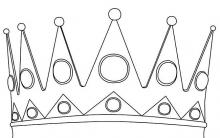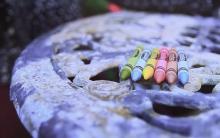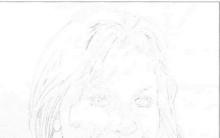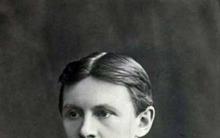Test based on Leo Tolstoy's story "After the Ball".
Novik Nadezhda Grigorievna,
teacher of the Russian language and literature at Vychegodskaya SKOSHI JSC.
1.Genre of the work:
a) story
c) story
2. Theme of the piece:
a) a story about the love of Ivan Vasilyevich;
b) a story about the colonel;
c) showing of Nikolaev Russia.
3. The story is based on an incident that occurred:
a) with Leo Tolstoy
b) with his brother Sergei
c) with a good friend
4. How can you characterize the meaning of the title of the story?
a) the importance of the hero's fate after the ball
b) the special significance of the scene of the massacre of the soldier
c) the importance of the morning following the ball
5. The number of storytellers in the work:
c) several
6. What is the type of story composition
a) story within story
b) first-person narration
7. Mark the location of the story.
a) Petersburg
b) Moscow
c) provincial city
8. Mark from whose person the story is being told.
b) colonel
c) Ivan Vasilievich
9. How does the narrator feel about the ball scene?
a) alienation
b) delight
c) indignation
10. With the help of what artistic detail does LN Tolstoy prove the sincerity of the colonel's feelings for his daughter?
a) suede glove
b) white mustache and sideburns
c) "homemade" boots
11. Ivan Vasilievich says about himself: "I was very ... and ... small, and even ..."
Rebuild the text:
a) cheerful and lively, and even rich;
b) rich and lively, and even cheerful;
c) rich and cheerful, and even lively.
12. What did Varenka look like at the ball? Recover the text (write the words separated by commas):
"She was in ... a dress with ... a belt and ... kid gloves, which did not reach the thin, sharp elbows, and ... satin shoes."
13. What color was Varenka's ball gown?
a) white
b) cream
c) blue
14. What dance was the first to be danced by the narrator and Varenka at the ball?
a) polonaise
c) mazurka
15. What rank was Varenka's father?
a) colonel
b) major
c) general
16. What did Ivan Vasilyevich do during the years of the events he described?
a) served in the hussar regiment
b) served at the office
c) studied at the university
17. What did Varenka and her father dance:
a) square dance;
c) mazurka.
18. What Varenka's father put on before dancing with her:
b) a suede glove;
c) military uniform.
19. Note what feelings the hero of the story experiences at the ball.
a) love for Varenka
b) love for Varenka and her father
c) love for the whole world, because he loves Varenka
20. After the ball Ivan Vasilievich had some of Varenka's things.
What kind of things?
a) a glove and a feather from a fan
b) a scarf and a feather from a fan
c) gloves and a fan
21. What kind of music did Ivan Vasilyevich hear when he entered the field where Varenka's house was?
a) cheerful, sonorous;
b) tough, bad;
c) rough, sharp.
22. The sounds of what musical instruments accompanied the execution of the soldier?
a) drum and tambourine
b) pipes and drum
c) flute and drum
23. What was the soldier punished for?
a) for disobeying an order
b) for theft
c) for escape
24. What is described in the story as"motley, wet, red, unnatural"?
a) the colonel's face
b) the back of the punished soldier
c) the face of the soldier being punished
25. What did the colonel do to the soldier who did not lower his stick hard enough on the back of the person being punished?
a) ordered to beat with sticks
b) hit in the chest
c) hit in the face
26. Why did the colonel, attentive and sensitive during the ball, turn out to be cruel and heartless towards the soldier?
a) sincerely believes in the need for cruel reprisals
b) put on a "mask" of decency at the ball
c) in good faith, without reasoning, performs his official duties
27. Note whether the narrator draws conclusions about what he saw on the parade ground.
a) no, he does not want to reason
b) yes, he is indignant, opposes arbitrariness
c) no, he does not draw conclusions, but his whole future life depends on what he saw
28. Note what feelings the hero of the story experiences after the scene on the parade ground.
a) resentment
b) powerlessness
29. To mark the state of the hero of the story after the events on the parade ground.
a) the colonel's behavior is incompatible with the hero's feeling of love
b) what happened convinced the hero of the impossibility of love
c) what happened is not understood by the hero, but he cannot love the heroine after what he saw
30. Mark how the hero's love story ended.
a) safely
b) love began to decline
c) the hero abruptly broke off relations with his beloved
Answers:
1 - C 2 - C 3 - B 4 - C 5 - B 6 - A 7 - C 8 - C 9 - B 10 - C 11 - A 13 - A14 - B 15 - A 16 - C
17 - C 18 - B 19 - C 20 - A 21 - B 22 - C 23 - C 24 - B 25 - C 26 - C 27 - C 28 - C 29 - C 30 - B
The main events of the story begin in the early morning, after the ball. Notice how colors, sounds, feelings change in this part. Some researchers also pay attention to the natural light of the early morning, as opposed to the artificial lighting of the ball. Instead of ladies in diamonds, the hero is surrounded by sledges with firewood, cabbies covered with matting, a blacksmith in a greasy sheepskin coat and an apron. In Ivan Vasilyevich's ears, the lovely music of the mazurka still sounds, which, as it seemed to him at first, continues on the street, but after listening, he can hear "some other, cruel, bad music." The white clothes of the ladies at the ball are replaced by the black uniforms of the soldiers gathered in the street. And only Varenka's father was still blush, slender, and still in the same homemade boots, he clearly walked next to the punished person and made sure that the soldiers lowered sticks on the Tatar's back with the appropriate force and did not "smear".
Slide 8 from the presentation "After the Ball" to literature lessons on the topic "After the ball"Dimensions: 960 x 720 pixels, format: jpg. To download a slide for free for use in a literature lesson, right-click on the image and click "Save Image As ...". You can download the entire presentation "After the Ball.ppt" in a zip-archive 1404 KB in size.
Download presentationAfter the ball
"Leo Tolstoy Russian writer" - 1844 - 1847 SOFIA ANDREEVNA BERS In 1862 L. Tolstoy married the daughter of a doctor. Childhood. L. Tolstoy "Confession". December 1874. Finally today I received the order to go to my battery, I am a 4th class fireworks. This is ... not a man, but a MAN, JUPITER. In 1851 L. Tolstoy left for the Caucasus and volunteered for the artillery.
"Kutuzov and Napoleon" - the Image of Napoleon. In the image of Tolstoy, Kutuzov is a living face. An important place in the novel "War and Peace" is occupied by the images of Kutuzov and Napoleon. Kutuzov and Napoleon in Leo Tolstoy's novel "War and Peace". Who won the 1812 War? What is the role of commanders in combat? Nesterov Andrey.
"Zhilin and Kostylin" - And does not know how to get out. And Zhilin, though small in stature, was daring. The Chechens began to take their guns out of their cases and split into two parties. Officer's honor - If a person is in conjunction with you. And one mountain of snow stands higher than the others. Quiet, light over the mountains, how everything died out. The wheel turns and the pupae jump.
"The Lesson of War and Peace" - The image of an oak tree in the novel. L.N. Tolstoy "I tried to write the history of the people." The role of landscapes in describing the battle. Vasily Denisov in a partisan detachment. Napoleon. Natasha Rostova. The genre of the epic novel. Defense of Smolensk. Pierre at Bazdeev's Artist M.S. Rodionov. Emperor Alexander I. The image of the "high sky". Lesson summary.
A distinctive feature of the life and work of the great Russian writer and thinker Lev Nikolaevich Tolstoy is constant moral searches. What is the true destiny of a person, how to relate to other people and generally accepted "truths" - all these questions are touched upon to one degree or another in his works. The writer speaks especially sharply and uncompromisingly about them in the novels, novellas and stories he created after the spiritual crisis experienced in the late 70s of the 19th century. The story "After the Ball" also belongs to those.
History of creation
In early April 1903, a major Jewish pogrom took place in the city of Chisinau, Bessarabian province of the Russian Empire. LN Tolstoy made a sharp condemnation of the rioters and the inactive authorities. The Committee for Assistance to Victims of the Pogrom organized a fundraiser. At the end of April, the famous Jewish writer Sholem Aleichem asked Leo Tolstoy "to give something" for a literary collection he was preparing for the same purpose. In a response letter, Lev Nikolayevich promised to fulfill his request.
On June 9, Tolstoy decided to write a story about an incident from the life of his brother Sergei Nikolaevich, evoking certain associations with the Chisinau pogrom. 75-year-old Lev Nikolayevich remembered this story from his student days, spent with his brothers in Kazan.
The plan for the future story was sketched in a diary entry dated June 18, 1903. The first version of the story, entitled "Daughter and Father", was written on August 5-6. Then Tolstoy changed the name to "And you say." The final edition of the story, entitled "After the Ball", was completed on August 20, 1903. The work was published after the writer's death in "Posthumous Works of Art by Leo Tolstoy" in 1911.
Description of the work

The narration is conducted on behalf of the main character - Ivan Vasilievich. In a familiar environment, he told two stories from his life when he was a student at a provincial university. They were supposed to illustrate his statement that the determining factor in the fate of a person is not the environment, but the chance.
Most of the story is occupied by the experiences of the hero, who on the last day of Maslenitsa attended a ball at the provincial leader. All the "cream" of the provincial society gathered there, including Varenka B., with whom the student was in love with him. She became the queen of the ball, and she was admired not only by men, but also by women whom she pushed into the background. So, at least, it seemed to the student Vanya. A beautiful girl favored him and gave most of the dances with her.
Varenka was the daughter of Colonel Pyotr Vladislavovich, who was also at the ball with his wife. At the end, those present persuaded the colonel to dance with his daughter. The couple was in the spotlight. Pyotr Vladislavovich remembered his former prowess and danced in a young dashing way. Vanya watched the couple with increased attention. The old-fashioned colonel's boots especially touched his soul. They guessed savings on themselves in order not to deny anything to their beloved daughter.

After the dance, the colonel said that he would get up early tomorrow, and did not stay for supper. And Ivan danced with Varenka for a long time. An unearthly feeling of happiness and absolute harmony of being seized the main character. He loved not only Varenka, her father, but the whole world, in which, as it seemed to him at that moment, there was nothing wrong.
Finally, the ball was over. Returning home in the morning, Ivan realized that from an excess of feelings he would not be able to fall asleep. He went out into the street and his feet carried him to Varenka's house, located on the outskirts of the city. As we approached the field adjacent to the house, drumming and unpleasant, shrill sounds of a flute sounded, drowning out the dance melodies that still sounded in Ivan's soul. There they let a fugitive Tatar soldier through the line. Other soldiers from both sides beat the unfortunate man on his bare back with a swing, and he only muttered exhaustedly: "Brothers, have mercy." His back had long ago turned into a bloody mess.

And Varenka's father supervised the execution, and he did it as diligently as he danced with his daughter the day before. When one small soldier hit the Tatar not hard enough, the colonel with his face twisted with anger began to hit him in the face for it. Ivan was shocked to the point of nausea by what he saw. His love for Varenka began to wane. The bloody back of the soldier tortured by her father stood between them.
main characters

The hero of the story, Ivan Vasilyevich, is endowed with a sense of compassion and the ability to put himself in the place of another person. Human misfortunes did not become simple life decorations for him, as for the absolute majority of representatives of the privileged estates. Ivan Vasilyevich's conscience is not drowned out by false expediency in life. These qualities were inherent to the highest degree and Tolstoy himself.

Colonel Pyotr Vladislavovich is a caring father and a good family man. Most likely, he considers himself to be a true Christian, serving God, the sovereign and the fatherland. But he, like most people at all times, is absolutely deaf to the main thing in Christianity - the great moral law of Christ. According to this law, people should be treated the way you would like them to treat you. Regardless of class and property partitions.

It is difficult to compose a psychological portrait of the beautiful Varenka. Most likely, it is unlikely that her external attractiveness was combined with the same soul. After all, she was brought up by her father, who in fact turned out to be a real fanatic in the public service.
Analysis of the story

The compositional dominant of the story is the opposition of its two parts, describing the events at the ball and after it. At first, the ball sparkling with light colors is a celebration of youth, love and beauty. It takes place on the last day of Shrovetide - Forgiveness Sunday, when believers must forgive each other for mutual sins. Then - dark colors, "bad music" beating on the nerves, and a cruel reprisal against the unfortunate soldiers, among whom the main victim is a non-believer (like the Chisinau Jews).
There are several main thoughts in the story. First of all, it is an absolute rejection of any violence, including one that is justified by state necessity. Secondly, the division of people, contrary to the will of God, into those who are worthy of respect and are likened to cattle.
Other motives are less obvious. In torturing a different believer on Forgiveness Sunday, Tolstoy allegorically continues to reproach the official church, which justifies state violence, from which he was excommunicated two years earlier.
The image of Ivan Vasilyevich, who is in love and careless, reminds Tolstoy of his own youth, to which the writer was critical. Oddly enough, but the young Tolstoy had common features with the colonel. In his other work ("Youth"), the writer writes about his own division of people into worthy and despised.
Literature. 8th grade.
Leo Tolstoy "After the ball" -
1. Mark the correct statement.
A. The plot is a story about the life of a hero
B. The plot is the actions and events from the life of the heroes
B. The plot is the actions and events in the life of the characters, taking place in space and time
2. Mark the scene of the story.
A. Petersburg
B. Moscow
V. Provincial town
G. County town
3. Mark from whose person the story is being told.
B. Colonel
V. Ivan Vasilievich
G. Engineer Anisimov
4. Note what feelings the hero of the story experiences at the ball.
A. Love for Varenka
B. Love for Varenka and her father
V. Love for the whole world, because he loves Varenka
5. Mark how the hero's love story ended.
A. Safely
B. Love began to decline
V. Hero abruptly broke off relations with his beloved
6. Mark the topic of conversation among the assembled listeners.
A. A person cannot himself understand that the whole thing is in the environment
B. For personal improvement, it is necessary first of all to change the conditions in which people live.
B. There are events that drastically change a person's whole life.
7. Note what the type of composition of the story is.
A. Story within a story
B. First-person narration
8. Mark the correct ratio of episodes by volume.
A. The description of the ball and the description of the execution occupy the same place.
B. The description of the ball takes more pages than the description of the execution
A. To add credibility to the story
B. Because the story in the first person makes it possible to convey the feelings and thoughts of the characters
B. Both options are correct.
10. Note whether the narrator draws conclusions about what he saw on the parade ground.
A. No, he does not want to reason
B. Yes, he is indignant, opposes arbitrariness
V. No, he does not draw conclusions, but his whole future life depends on what he saw
11. Mark the most accurate definition of the concept of "antithesis".
A. Antithesis is a comparison of different concepts
B. Contrasting concepts
B. Stylistic figure of contrast, sharp opposition
12. Mark the correct statement.
A. In the story of Leo Tolstoy protests against the Nikolaev reality
B. In the story of L.N. Tolstoy declares the moral responsibility of man for what is happening
V. In the story of Leo Tolstoy calls for the fight against arbitrariness
13. Mark the time of the action in the story.
A. Reign of Alexander I
B. Reign of Nicholas I
C. Reign of Alexander II
A. From the lips of those present at the ball
15. Note what feelings the hero of the story experiences after the scene on the parade ground.
A. Resentment
B. Powerlessness
V. Toscu
16. Note the state of the hero of the story after the events on the parade ground.
A. Colonel's behavior is incompatible with the hero's feeling of love
B. What happened convinced the hero of the impossibility of love
C. What happened is not understood by the hero, but he cannot love the heroine after what he has seen
17. Mark the correct option.
A. The key episode in the story is the ball scene
B. The key episode in the story is the description of the execution
18. Note how the author's image manifests itself in the story.
Answers:
1 - B
2 - B
3 - B
4 - B
5 B
6 - B
7 - A
8 - B
9 - B
10 - B
11 - B
12 - B
13 - B
14 - B
15 - B
16 - B
17 - B
18 - B
On the subject: methodological developments, presentations and notes
Literature test grade 9. Test for "The Lay of Igor's Regiment" and literature of the 18th century.
Purpose of testing: checking knowledge of the studied works of Old Russian literature and literature of the 18th century ...
Test questions on literature (universal for all classes). Test on literature according to the program of V. Ya. Korovina (in the system "Znak") for grade 7
Final test on literature (universal suitable for all grades) 1. Which of the books I read this year do I remember the most? A) ...
Literature test for hard of hearing students in grade 8. Test based on the story of N.V. Gogol's "Taras Bulba".
This material is designed for students who are hard of hearing in Grade 8. The tasks are designed in the form of a test based on the story of N.V. Gogol's "Taras Bulba". In the test, work is underway to develop a comparative character ...
Russian language and literature teacher - Z.V. Pankova
MBOU "Poselskaya secondary school"
Bichursky district, Republic of Buryatia
Test: Leo Tolstoy "After the ball" - grade 8
1. Mark the correct statement.
A. The plot is a story about the life of a hero
B. The plot is the actions and events from the life of the heroes
B. The plot is the actions and events in the life of the characters, taking place in space and time
2. Mark the scene of the story.
A. Petersburg
B. Moscow
V. Provincial town
G. County town
3. Mark from whose person the story is being told.
B. Colonel
V. Ivan Vasilievich
G. Engineer Anisimov
4. Note what feelings the hero of the story experiences at the ball.
A. Love for Varenka
B. Love for Varenka and her father
V. Love for the whole world, because he loves Varenka
5. Mark how the hero's love story ended.
A. Safely
B. Love began to decline
V. Hero abruptly broke off relations with his beloved
6. Mark the topic of conversation among the assembled listeners.
A. A person cannot himself understand that the whole thing is in the environment
B. For personal improvement, it is necessary first of all to change the conditions in which people live.
B. There are events that drastically change a person's whole life.
7. Note what the type of composition of the story is.
A. Story within a story
B. First-person narration
8. Mark the correct ratio of episodes by volume.
A. The description of the ball and the description of the execution occupy the same place.
B. The description of the ball takes more pages than the description of the execution
9. Note why the author needs the image of a storyteller.
A. To add credibility to the story
B. Because the story in the first person makes it possible to convey the feelings and thoughts of the characters
B. Both options are correct.
10. Note whether the narrator draws conclusions about what he saw on the parade ground.
A. No, he does not want to reason
B. Yes, he is indignant, opposes arbitrariness
V. No, he does not draw conclusions, but his whole future life depends on what he saw
11. Mark the most accurate definition of the concept of "antithesis".
A. Antithesis is a comparison of different concepts
B. Contrasting concepts
B. Stylistic figure of contrast, sharp opposition
12. Mark the correct statement.
A. In the story of Leo Tolstoy protests against the Nikolaev reality
B. In the story of L.N. Tolstoy declares the moral responsibility of man for what is happening
V. In the story of Leo Tolstoy calls for the fight against arbitrariness
13. Mark the time of the action in the story.
A. Reign of Alexander I
B. Reign of Nicholas I
C. Reign of Alexander II
A. From the lips of those present at the ball
15. Note what feelings the hero of the story experiences after the scene on the parade ground.
A. Resentment
B. Powerlessness
V. Toscu
16. Note the state of the hero of the story after the events on the parade ground.
A. Colonel's behavior is incompatible with the hero's feeling of love
B. What happened convinced the hero of the impossibility of love
C. What happened is not understood by the hero, but he cannot love the heroine after what he has seen
17. Mark the correct option.
A. The key episode in the story is the ball scene
B. The key episode in the story is the description of the execution
18. Note how the author's image manifests itself in the story.
Answers:
1 - B
2 - B
3 - B
4 - B
5 B
6 - B
7 - A
8 - B
9 - B
10 - B
11 - B
12 - B
13 - B
14 - B
15 - B
16 - B
17 - B
18 - B











Jordan staircase. The path to glory. Hermitage non-standard St. George Hall. Distinctive feature: the main throne of the Winter Palace is located here
Theater "beyond the black river"
State Hermitage Hermitage plan
How to get to the Hermitage and what to see there first Scheme of the Hermitage halls
Satire theater on vasilievsky